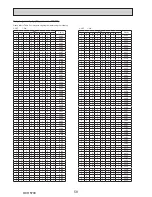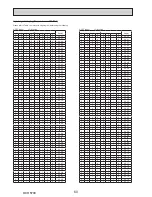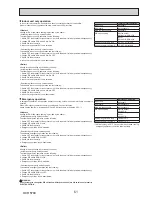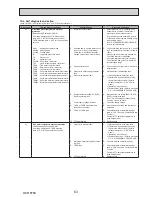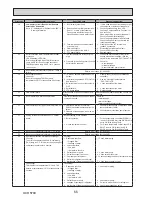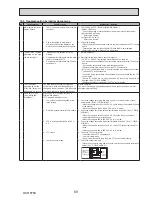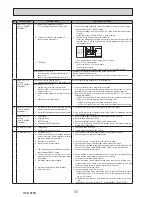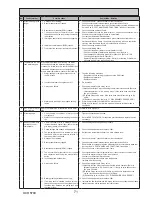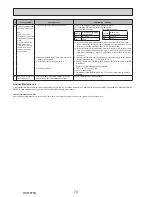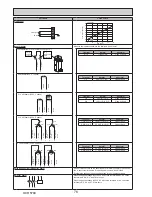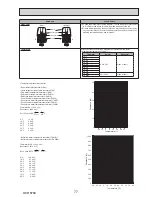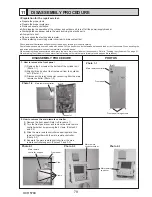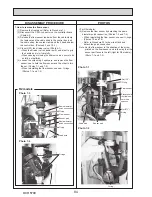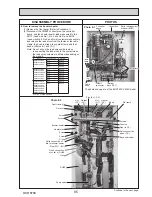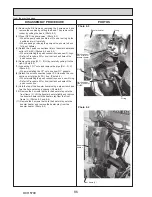
72
No.
Fault symptom
Possible cause
Explanation - Solution
14
In 2-zone tempera
-
ture control, only
Zone2 does not
reach the set tem-
perature.
1.
When Zone1 and Zone2 are both in heating
mode, the hot water temperature in Zone2
does not exceed that in Zone1.
1. Normal action no action necessary.
2.
Faulty wiring of motorized mixing valve
2.
Refer to installation manual, "5.3 Wiring for 2-zone temperature control".
3.
Faulty installation of motorized mixing valve
3.
Check for correct installation. (Refer to the manual included with each motor
-
ized mixing valve.)
4.
Incorrect setting of Running time
4.
Check for correct setting of Running time.
5.
Motorized mixing valve failure
5.
Inspect the mixing valve. (Refer to the manual included with each motorized
mixing valve.)
15 When a PUHZ-FRP
outdoor unit is con-
nected, DHW or Heat-
ing operation cannot
run.
The outdoor unit is set to have operation of the
indoor unit of air conditioner take precedence over
that of the cylinder unit, and in the main remote
controller settings "Electric heater (Heating)" or
"Electric heater (DHW)" is turned off.
Turn ON Electric heater (Heating) or Electric heater (DHW) using the main re
-
mote controller.
16 When a PUHZ-FRP
outdoor unit is con-
nected and is in heat
recovery operation,
the set temperature
is not reached.
When the outdoor unit is set to have cooling
operation of the indoor unit of air conditioner take
precedence over that of the cylinder unit, the out-
door unit controls the frequency of the compres-
sor according to the load of air conditioner. The
DHW and heating run according to that frequency.
Normal operation no action necessary.
If Air-to-Water system is given priority in operation, comp Hz can be regulated
depending on the load of DHW or Heating. For more details, refer to the PUHZ-
FRP installation manual.
17 After DHW operation
room temperature
rises slightly.
At the end of the DHW mode operation the 3-way
valve diverts hot water away from the DHW circuit
into space heating circuit.
This is done to prevent the cylinder unit compo-
nents from overheating.
The amount of hot water directed into the space
heating circuit varies according to the type of the
system and of the pipe run between the plate heat
exchanger and the cylinder unit.
Normal operation no action necessary.
18 The room tempera-
ture rises during DHW
operation.
3-way valve failure
Check the 3-way valve.
(i) Manually override 3-way valve using the main remote controller. (Refer to
<Manual operation> in "9-4. Service menu".) If the 3-way valve does not
function, go to (ii) below.
(ii) Replace 3-way valve coil. If the 3-way valve coil is replaced but the 3-way
valve does not function go to (iii) below.
(iii) Replace 3-way valve. (Refer to "11. DISASSEMBLY PROCEDURE".)
19
Water discharges
from pressure relief
valve.
(Primary circuit)
1. If continual – pressure relief valve could bite
foreign objects and the valve seat may be
damaged.
1.
Turn the handle on the pressure relief valve several turns. If leakage persists,
replace the pressure relief valve with a new one.
2.
If intermittent – expansion vessel charge may
have reduced/bladder perished.
2.
Check pressure in expansion vessel.
Recharge to 1 bar if necessary.
If bladder perished replace expansion vessel with a new one.
20
Water discharges
from pressure relief
valve.
(Sanitary circuit)
1.
If continual – field supplied pressure reducing
valve not working.
1.
Check function of pressure reducing valve and replace if necessary.
2. If continual – pressure relief valve could bite
foreign objects and the valve seat may be
damaged.
2.
Turn the handle on the pressure relief valve several turns. If leakage persists,
replace the pressure relief valve with a new one.
3.
If intermittent – expansion vessel charge may
have reduced/bladder perished.
3.
Check gas-side pressure in expansion vessel.
Recharge to correct precharge pressure if necessary.
If bladder perished replace expansion vessel with a new one with appropriate
pre-charge.
4.
DHW tank may have subjected to backflow.
4. Check the pressure in DHW tank. If pressure in DHW tank is similar to that in
the incoming mains, cold water supply that merges with incoming mains wa
-
ter supply could flow back to DHW tank. Investigate source of back-feed and
rectify error in pipework/fitting configuration. Adjust pressure in cold supply.
21
Water discharges
from temperature
and pressure relief
valve
(EH*T20*-MHCW only)
(Sanitary circuit)
1.
If continual – field supplied pressure reducing
valve not working.
1.
Check function of pressure reducing valve and replace if necessary.
2. If continual – temperature and pressure relief
valve could bite foreign objects and the valve
seat may be damaged.
2. Turn the handle on the temperature and pressure relief valve several turns.
If leakage persists, replace the temperature and pressure relief valve with a
new one.
3.
If intermittent – expansion vessel charge may
have reduced/bladder perished.
3.
Check gas-side pressure in expansion vessel.
Recharge to correct precharge pressure if necessary.
If bladder perished replace expansion vessel with a new one with appropriate
pre-charge.
4.
DHW tank may have subjected to backflow.
4. Check pressure in DHW tank. If pressure in DHW tank is similar to that in the
incoming mains, cold water supply that merges with incoming mains water
supply could flow back to DHW tank. Investigate source of back-feed and
rectify error in pipework/fitting configuration. Adjust pressure in cold supply.
5. Unit has overheated – thermal controls have
failed.
5.
Switch off power to the heat pump and immersion heaters.
Leave water running.
Wait until discharge stops. Isolate water supply and replace if faulty.
OCH570C
Summary of Contents for EHPT20X-MHCW
Page 108: ......

